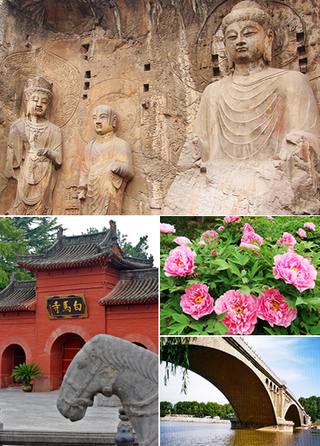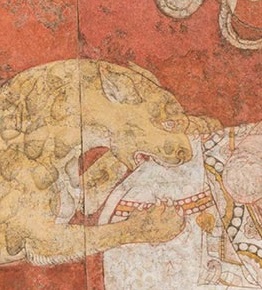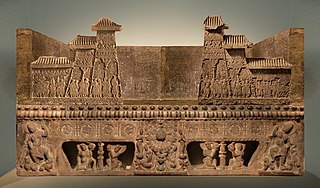Related Research Articles

Samarkand or Samarqand is a city in southeastern Uzbekistan and among the oldest continuously inhabited cities in Central Asia. Samarqand is the capital of Samarqand Region and a district-level city, that includes the urban-type settlements Kimyogarlar, Farhod and Khishrav. With 551,700 inhabitants (2021), it is the third-largest city of Uzbekistan.

The Silk Road was a network of Eurasian trade routes active from the second century BCE until the mid-15th century. Spanning over 6,400 kilometers, it played a central role in facilitating economic, cultural, political, and religious interactions between the East and West. The name "Silk Road," first coined in the late 19th century, has fallen into disuse among some modern historians in favor of Silk Routes, on the grounds that it more accurately describes the intricate web of land and sea routes connecting Central, East, South, Southeast, and West Asia as well as East Africa and Southern Europe.

Tashkent or Toshkent is the capital and largest city of Uzbekistan. It is the most populous city in Central Asia, with a population of 3 million. It is located in northeastern Uzbekistan, near the border with Kazakhstan.

Sogdia or Sogdiana was an ancient Iranian civilization between the Amu Darya and the Syr Darya, and in present-day Uzbekistan, Turkmenistan, Tajikistan, Kazakhstan, and Kyrgyzstan. Sogdiana was also a province of the Achaemenid Empire, and listed on the Behistun Inscription of Darius the Great. Sogdiana was first conquered by Cyrus the Great, the founder of the Achaemenid Empire, and then was annexed by the Macedonian ruler Alexander the Great in 328 BC. It would continue to change hands under the Seleucid Empire, the Greco-Bactrian Kingdom, the Kushan Empire, the Sasanian Empire, the Hephthalite Empire, the Western Turkic Khaganate and the Muslim conquest of Transoxiana.

Luoyang is a city located in the confluence area of the Luo River and the Yellow River in the west of Henan province. Governed as a prefecture-level city, it borders the provincial capital of Zhengzhou to the east, Pingdingshan to the southeast, Nanyang to the south, Sanmenxia to the west, Jiyuan to the north, and Jiaozuo to the northeast. As of December 31, 2018, Luoyang had a population of 6,888,500 inhabitants with 2,751,400 people living in the built-up area made of the city's five out of six urban districts and Yanshi District, now being conurbated. By the end of 2022, Luoyang Municipality had jurisdiction over 7 municipal districts, 7 counties and 1 development zone. The permanent population is 7.079 million.
The Sogdian language was an Eastern Iranian language spoken mainly in the Central Asian region of Sogdia, located in modern-day Uzbekistan, Tajikistan, Kazakhstan and Kyrgyzstan; it was also spoken by some Sogdian immigrant communities in ancient China. Sogdian is one of the most important Middle Iranian languages, along with Bactrian, Khotanese Saka, Middle Persian, and Parthian. It possesses a large literary corpus.

Jizzakh is a city and the center of Jizzakh Region in Uzbekistan, located in the northeast of Samarkand. Jizzakh is a district-level city. The population of Jizzakh is 179,200.
The Western Turkic Khaganate or Onoq Khaganate was a Turkic khaganate in Eurasia, formed as a result of the wars in the beginning of the 7th century after the split of the First Turkic Khaganate, into a western and an eastern Khaganate.

The Afrasiab murals, also called the Paintings of the Ambassadors, is a rare example of Sogdian art. It was discovered in 1965 when the local authorities decided to construct a road in the middle of Afrāsiāb mound, the old site of pre-Mongol Samarkand. It is now preserved in a special museum on the Afrāsiāb mound.

The Disaster of Yongjia refers to an event in Chinese history that occurred in 311 CE, when forces of the Xiongnu-led Han-Zhao dynasty captured and sacked Luoyang, the capital of the Western Jin dynasty. After this victory, Han's army committed a massacre of the city's inhabitants, killing the Jin crown prince, a host of ministers, and over 30,000 civilians. They also burnt down the palaces and dug up the Jin dynasty's mausoleums. This was a pivotal event during the Upheaval of the Five Barbarians and the early Sixteen Kingdoms era, and it played a major role in the fall of the Western Jin dynasty in 316 CE.

Afrasiyab ,(Persian: افراسيابafrāsiyāb) is an ancient site in Northern Samarkand, present day Uzbekistan, that was occupied from c. 500 BC to 1220 AD prior to the Mongol invasion in the 13th century. The oldest layers date from the middle of the first millennium BC. Today, it is a hilly grass mound located near the Bibi Khanaum Mosque. Excavations uncovered the now famous Afrasiab frescoes exposed in the Afrasiab Museum of Samarkand, located next to the archaeological site.

Iranian people, such as Persians and Sogdians, have lived in China throughout various periods in history.

Central Asian art is visual art created in Central Asia, in areas corresponding to modern Kyrgyzstan, Kazakhstan, Uzbekistan, Turkmenistan, Tajikistan, Afghanistan, and parts of modern Mongolia, China and Russia. The art of ancient and medieval Central Asia reflects the rich history of this vast area, home to a huge variety of peoples, religions and ways of life. The artistic remains of the region show a remarkable combinations of influences that exemplify the multicultural nature of Central Asian society. The Silk Road transmission of art, Scythian art, Greco-Buddhist art, Serindian art and more recently Persianate culture, are all part of this complicated history.

Afrasiab Museum of Samarkand is a museum located at the historical site of Afrasiyab, one of the largest archaeological sites in the world and the ancient city that was destroyed by the Mongols in the early 13th century. Museum building and the archaeological site are located in the north-eastern part of the city of Samarkand in the Central Asian country of Uzbekistan. It bears the name of Afrasiab, mythical king and hero of Turan. Permanent exhibition of the Afrasiab Museum of Samarkand is focused on the history of the city itself as well as the surrounding region. The museum building was designed by Armenian architect Bagdasar Arzumanyan in 1970, at the time when Uzbek Soviet Socialist Republic was still part of the Soviet Union. The opening of the museum was dedicated to the 2500th anniversary of the founding of the city of Samarkand. Thematically, the museum is divided into five rooms dedicated to different periods of life in the fort of Afrasiyab.

Huteng was the Chinese term for a type of dance that originated in Central Asia, especially among the Sogdians and the region of Tashkent. The dance was well known during the Tang dynasty, and there are numerous depictions of it in works of art. The dance was characterized by spinning, leaps and backflips. The dancers would particularly make summersaults, first planting their feet firmly on the carpet, tilting their face upward and arching their body, then lift their arms and jump backward to the sound of flutes and the pipa.

Sogdian art refers to art produced by the Sogdians, an Iranian people living mainly in ancient Sogdia, present-day Uzbekistan, Tajikistan, Kazakhstan, and Kyrgyzstan, who also had a large diaspora living in China. Its apex was between the 5th and 9th centuries, and it consists of a rich body of pre-Muslim Central Asian visual arts. New finds recovered in the past decades allowed scholars to achieve a better understanding of Sogdian art.

Varkhuman, also Vargoman was an Ikhshid (King) of Sogdia, residing in the city of Samarkand in the 7th century CE. He succeeded King Shishpin. He is known from the Afrasiab murals of Afrasiyab in Samarkand, where he is seen being visited by embassies from numerous countries, including China. There is also an inscription in the murals directly mentioning him. His name is also known from Chinese histories.

The Sogdian Whirl dance or Sogdian Whirl was a Sogdian dance imported into China in the first half of the first millennium AD. The dance was imitated by the Chinese and became popular in China, where it went on to be performed at court.

The Ikhshids of Sogdia, or Ikhshids of Samarkand, were a series of rulers of Soghdia in Transoxiana, with their capital at Samarkand, during the pre-Islamic and early Islamic periods.

The Anyang funerary bed, also known locally as the Bed of Ts'ao Ts'ao, is a Chinese funerary couch belonging to a Sogdian merchant and official active in China in the 6th century CE. The tomb was discovered in 1911, and the components of the funerary bed were dispersed among various museums in the world after being offered on the art market. It is thought the funerary bed was excavated in Anyang, capital of the Northern Qi dynasty. It is stylically dated to the Northern Qi dynasty.
References
- ↑ Vyzgo T.S. The Afrasiab Lute. //From the History of the Great City. Tashkent, 1972.
- ↑ Meshkeris V.A. Terracottae in Samarkand Museum. Moscow, 1962.
- ↑ Rtveladze E.V. The Great Silk Road. Tashkent, 1999.
- ↑ Belenitskiy A.M. The New Memorials of the Art of Ancient Pandjikent. //Sculpture and Pictorial Art of Ancient Pandjikent. Moscow, 1959.
- ↑ Les Sogdiens en Chine. //Ecole franciasa d’Extreme-Orient. Paris, 2005.
- ↑ Vyzgo T.S. The Afrasiab Lute. //From the History of the Great City. Tashkent, 1972.
- ↑ Shirinov T.Sh., Berdimuradov A.E., Raimkulov A.A. The Land That Raised Oriental Music. 74 pages. Samarkand, 2009.